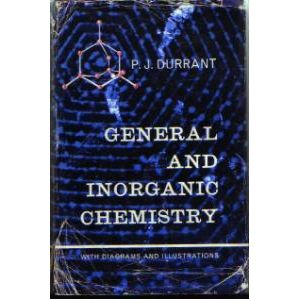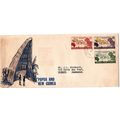| General and Inorganic Chemistry Hardback book with Dust Jacket by P.J. Durrent With Diagrams and Illustrations Over 650 pages; Second Edition Longmans, Green and Co. Ltd Made and Printed in Great Britain by Butler & Tanner Ltd First published 1939 Second Edition 1952 Last date of " New Impression" is New Impression 1962 This is an account of the modern outlook on organic chemistry specially designed for students preparing for 'A' level G.C.E., university scholarships and pre-medical and first-year university examinations.
It emphasizes that the diverse phenomena of inorganic chemistry conform to a pattern and seeks to awaken interest in the problems of the constitution and clasification of chemical substances.
Except for a discussion on the atomic and molecular theories all historical treatment has been discarded.
Present-day theories explaining the behaviour and properties of chemical substances are stated as plainly and simply as possible and are also used to explain the chemistry of the elements and compounds.
The electronic theory of valency is boldly set out and the constitutions of all compounds subsequently mentioned are discussed in terms of this theory of valency.
All the mathematical arguments can be followed without a knowledge of the calculus. " " Much of ths book was re-written for this Second Edition.
The most important changes are the inclusion of two new chapters on colloids and nuclear chemistry and extensive modifications in the chapters on periodic classification, atomic structure and valency, electrolytes, electrode potential and electrolysis.
The range of examination questions included at the end of the book has been extended. " Contents include: " Chapter I. Introduction Chapter II. The Atomic and Molecular Theories Chapter III. States of Matter Chapter IV. Molecular Weights, Atomic Weights, and Equivalents Chapter V. The Periodic Classification, Atomic Structure, and Valency Chapter VI. Solution Chapter VII. Velocity of Reaction: Law of Mass Action: Equilibria Chapter VIII. Electrolytes Chapter IX. Electrode Potential and Electrolysis Chapter X. Colloids Chapter XI. Hydrogen Chapter XII. Oxygen Chapter XIII. Water and Hydrogen Peroxide Chapter XIV. Group I. The Alkali Metals Chapter XV. Group II.: Sub-Group N. The Alkaline Earth Metals Chapter XVI. Group II. (Continued): Sub-Group T. Zinc and Mercury Chapter XVII. Group III.: Sub-Group N. Boron and Aluminium Chapter XVIII. Group IV: Sub-Group N. Carbon and Silicon Chapter XIX. Group IV: Sub-Group N (Continued): Tin and Lead Chapter XX. Group V: Sub-Group N Nitrogen Chapter XXI. Group V: Sub-Group N (Continued): Phosphorus, Aresenic, and Antimony Chapter XXII. Group VI: Sub-Group N. Oxygen and Sulphur Chapter XXIII. Group VII: Sub-Group N. The Halogens Chapter XXIV. Group VIII. Transition Series of the First Long Period Chapter XXV. Group XI. The Coinage Metals: Copper, Silver, and Gold Chapter XXVI. Nuclear Chemistry " The book is in pretty good condition with several dirt marks on the side edges of the pages, mostly visible from the side view.
However, the dust jacket is very worn with several tears and stains on the inside.
No torn or ripped pages. There are a few stamped registerd name marks on the inside front cover and the beginning and ending pages, plus a small book store sticker on the inside front cover. |







 for 1 item(s)
for 1 item(s)

















